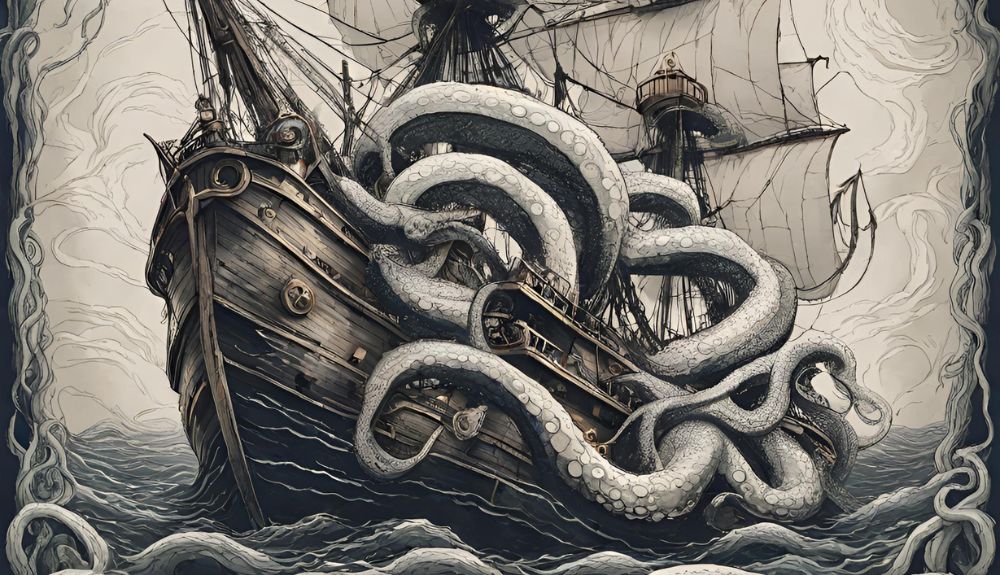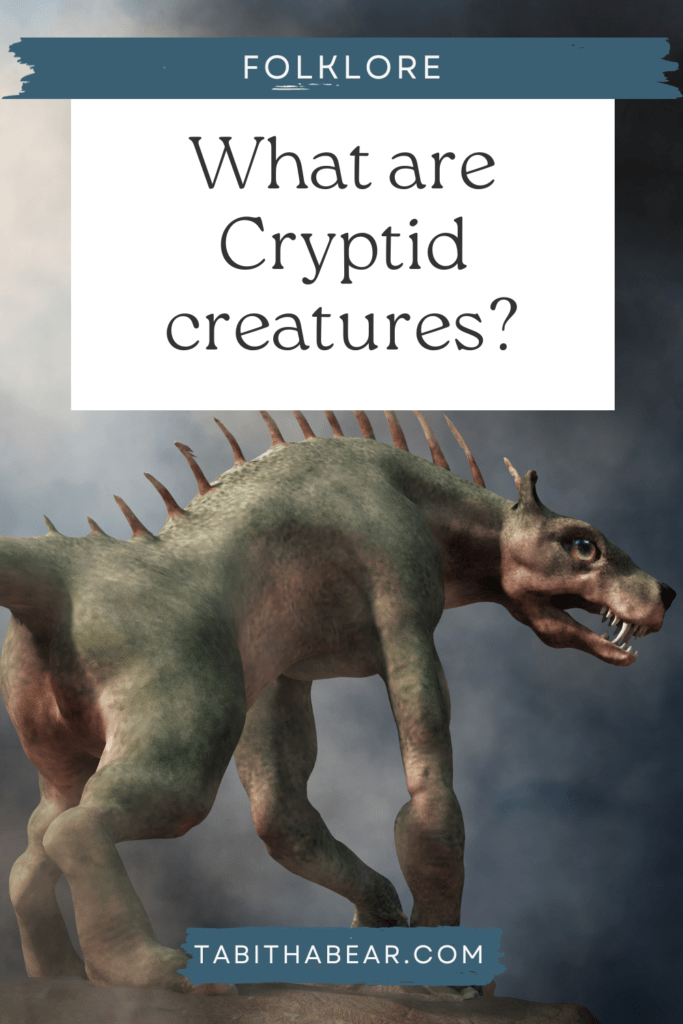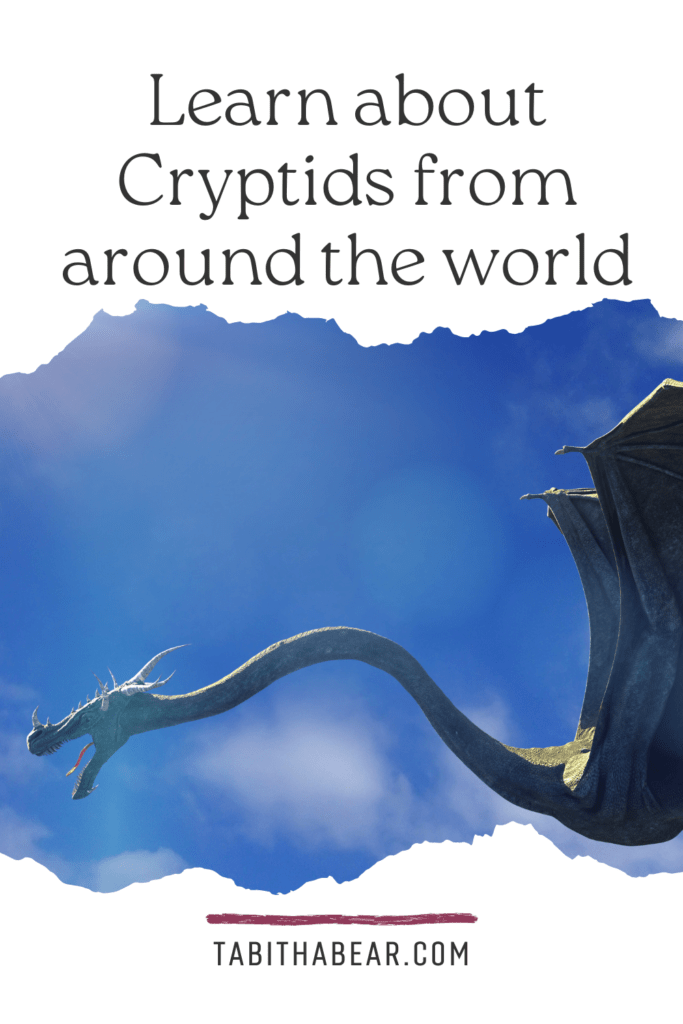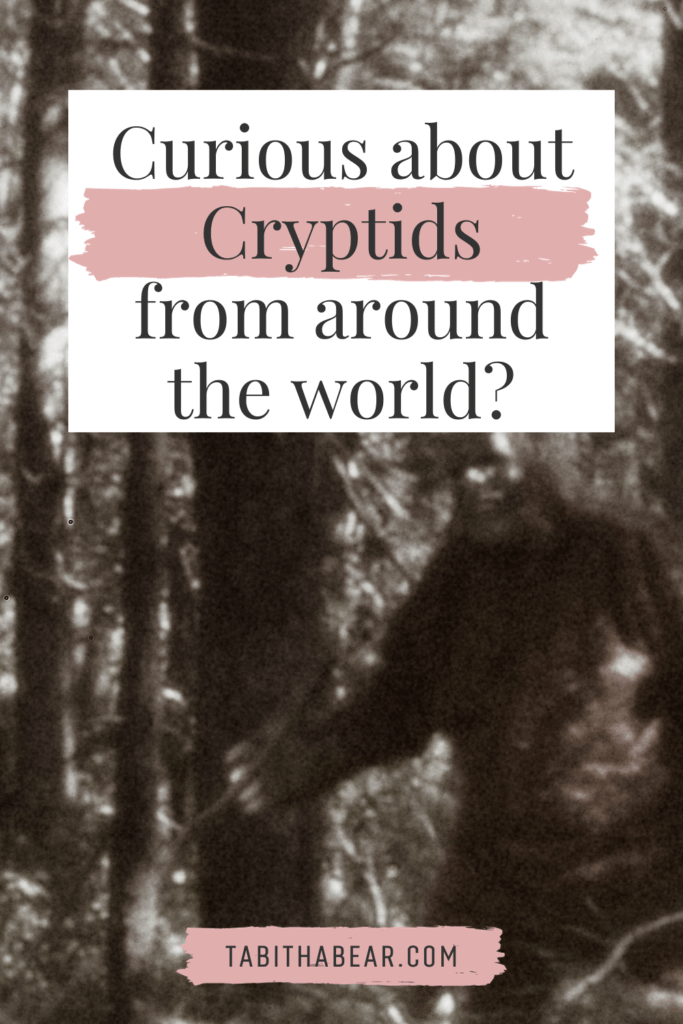
These animals are not disputed but ‘hidden.’ It is an optimistic mission statement. It would be quixotic to seek gremlins that exist no further than storybooks. Bigfoot exists, along with Nessie and the Jersey Devil. Their formal discovery will happen tomorrow, or next week at the latest, and wont’ you feel silly when they are?
Thomm Quackenbush
Cryptids are where it all began for me falling in love with mythology and folklore from different cultures. I’m beyond excited to share this post with you as we go down the Cryptid rabbit-hole.
What Are Cryptids?
Cryptids are creatures of folklore and legend, often elusive and unverified, that capture the human imagination with their mysterious and sometimes frightening characteristics. These enigmatic beings range from legendary sea monsters and ape-like creatures to winged beasts and elusive lake-dwelling creatures.
They are often the subjects of local stories and myths, passed down through generations. They have become a fascinating part of popular culture. While skeptics often consider cryptids to be products of myth, enthusiasts maintain that some of these cryptids may be unknown or extinct species yet to be discovered.
Regardless of their existence, cryptids continue to intrigue, offering a sense of wonder and the possibility that the natural world still holds secrets waiting to be uncovered.
Popular Cryptids
You might know some or all of these cryptids. Whether from cartoons, movies, or hearing the stories, these are the more popular cryptids from around the world.
The Kraken
A personal favorite of mine, the Kraken is a maritime legend. Rooted in Scandinavian folklore, Kraken is derived from the Norwegian word ‘krake’ which means “unhealthy animal/twisted.”
The Kraken has been described in various ways, but it is most commonly depicted as a massive cephalopod, resembling a giant squid or octopus. In some accounts, it was said to be as large as an island, with tentacles that could reach the surface and drag entire ships and their crews beneath the waves.
While the Kraken remains a mythological creature, some aspects of its legend have parallels in real-life marine biology. Giant squids and colossal squids, for example, are massive cephalopods that dwell in the ocean’s depths and have been discovered by scientists.
The Kraken’s legend continues to captivate the human imagination, serving as a symbol of the vast, uncharted mysteries of the deep sea. Its enduring legacy in folklore and popular culture reminds us of the enduring fascination with the unknown depths of our world’s oceans.
Sasquatch/Bigfoot
The legend of Bigfoot has its roots in Indigenous North American folklore, particularly among tribes in the Pacific Northwest. Various indigenous cultures have their own names and stories about large, hairy, human-like creatures inhabiting the wilderness.
Bigfoot is typically described as a massive, bipedal, ape-like creature covered in dark or reddish-brown fur. It stands between 7 to 10 feet tall and leaves distinctive, large footprints, which have become a hallmark of Bigfoot sightings.
Bigfoot’s legend persists as one of the most enduring and enigmatic cryptids in the world. It represents the fascination with the mysteries of the wilderness and the desire to explore and understand the hidden corners of our planet. Whether one believes in its existence or not, Bigfoot continues to captivate the imagination and fuel discussions about the unknown.
Loch Ness Monster
The Loch Ness Monster, often affectionately referred to as “Nessie,” is a legendary and enigmatic creature. It’s said to inhabit Loch Ness, a large, deep lake in the Scottish Highlands.
Tales of a mysterious creature in Loch Ness date back centuries, with the earliest accounts possibly stemming from Celtic folklore. However, Nessie’s modern legend gained significant attention in the early 20th century.
Nessie is often described as a long-necked, aquatic creature with humps on its back, reminiscent of a plesiosaur or a sea serpent. Descriptions vary, but its appearance typically includes a long neck protruding from the water.
Loch Ness has been the subject of numerous scientific investigations and expeditions, including sonar surveys and underwater cameras. These have yielded some ambiguous results but no definitive evidence of Nessie’s existence.
The Loch Ness Monster, with its enduring mystery and folklore, represents the allure of the unknown and the ongoing quest to explore and understand the hidden wonders of our world’s lakes and oceans. While the Loch Ness Monster’s existence remains unproven, its legend has become an integral part of Scotland’s cultural heritage.
El Chupacabra
FUN FACT – when I was in high school, I created a B-horror film about El Chupacabra. It was awesomely horrible. It attacked and killed all my friends.
El Chupacabra, which translates to “goat-sucker” in Spanish, is a cryptid and mythical creature from Latin American folklore. It is known for its reputed attacks on livestock, particularly goats, and has inspired a mix of fear and fascination.
The Chupacabra legend first emerged in Puerto Rico in the 1990s but quickly spread to other Latin American countries. Also, the southwestern United States, and even as far as the Philippines. Variations of the Chupacabra myth include descriptions ranging from a reptilian creature to a more alien or vampire-like being.
Descriptions of El Chupacabra vary, but it is often portrayed as a small, humanoid creature, with spines or quills along its back. Some versions depict it as having red or glowing eyes. (For the B-horror film, our Chupacabra was a hand with a wadded up ball of fake hair.)
Over the years, various hoaxes and urban legends have perpetuated the myth of El Chupacabra. These stories often involve gruesome images or tall tales that stoke fear and intrigue.
El Chupacabra embodies the allure of the mysterious and the unexplained, drawing on both folkloric elements and contemporary legend. While it has become a popular subject in the realm of cryptozoology and urban legends, its existence remains unverified by scientific evidence, and many consider it a product of folklore and local superstition.
Lesser-Known Cryptids
Let’s explore some lesser-known cryptids from around the world that have ignited the curiosity of cryptozoologists just the same as the popular creatures.
Mokele-Mbembe
Mokele-Mbembe is a cryptid and legendary creature said to inhabit the Congo Basin in Central Africa. The name “Mokele-Mbembe” is derived from Lingala, a Bantu language, and roughly translates to “one who stops the flow of rivers.”
Mokele-Mbembe is typically described as a large, semi-aquatic reptilian creature, resembling a sauropod dinosaur or a long-necked dinosaur. It is often depicted with a long neck, a body like a hippopotamus, and a small head with sharp teeth.
Mokele-Mbembe has captured the interest of cryptozoologists and adventurers who have conducted expeditions to search for evidence of its existence, including footprints and eyewitness testimonies.
Scientific skepticism remains high regarding the existence of Mokele-Mbembe. Many sightings and alleged evidence can be attributed to known animals or misidentifications. The remote and challenging terrain of the Congo Basin adds further difficulty to exploration.
Mokele-Mbembe is an important cultural and spiritual figure among indigenous peoples in the region. It represents the connection between the natural world and their beliefs, particularly concerning the spirits of the land and water.
The search for Mokele-Mbembe has raised awareness about the need to protect the Congo Basin’s unique and fragile ecosystems, encouraging conservation efforts.
Mokele-Mbembe embodies the fascination with ancient and enigmatic creatures and the allure of unexplored regions. While evidence for its existence remains elusive, the cryptid continues to be a subject of exploration.
Bunyip
The Bunyip is a cryptid and mythical creature from Aboriginal Australian folklore, known for its association with waterholes, rivers, and swamps. It has long captured the imagination and curiosity of both indigenous and non-indigenous Australians.
Descriptions of the Bunyip vary, but it is often portrayed as a water-dwelling creature with features reminiscent of different animals, such as a crocodile, a seal, a long-necked turtle, or an unknown aquatic beast.
Among Aboriginal communities, the Bunyip holds cultural significance. It is often seen as a spirit of the land and water, with various stories and rituals associated with it.
While the Bunyip remains a compelling part of Australian mythology, many view it as a product of folklore and local superstition. Some aspects of Bunyip sightings can be attributed to known animals or natural phenomena.
The Bunyip embodies the connection between indigenous Australian cultures and the natural world. Particularly because of the unique and often unforgiving Australian landscape. Whether seen as a mythical creature, a spiritual guardian, or a figure of cultural significance, the Bunyip continues to be a symbol of the rich cultural diversity and ancient beliefs of Australia’s first peoples.
Mapinguari
The Mapinguari is a cryptid and legendary creature from the Amazon rainforest, particularly found in Brazilian and South American folklore. It is known for its fearsome appearance and is believed to inhabit the remote, dense jungles of the Amazon.
The Mapinguari is typically described as a massive, ape-like creature with thick, shaggy fur covering its body. It is known for its distinctive, backward-facing feet, which make its tracks appear to be leading in the wrong direction. It is often depicted with a large, gaping mouth and sharp teeth.
Mapinguari is believed to inhabit the deepest, most remote parts of the Amazon rainforest, particularly swampy areas and dense jungles. It is often described as a solitary, nocturnal creature known for its vocalizations, including eerie screams and howls.
The Mapinguari has become a symbol of the mysteries and uncharted regions of the Amazon. It has inspired works of art, literature, and documentaries, contributing to the allure of the rainforest.
The Mapinguari embodies the deep connection between indigenous cultures and the Amazon rainforest, emphasizing the significance of preserving and respecting this unique and vital ecosystem. While its existence remains unverified by concrete evidence, the cryptid continues to serve as a symbol of the richness and spiritual significance of the world’s largest tropical rainforest.
In the world of cryptids, mystery and wonder blend with tales of the unknown, keeping the human imagination forever captivated. These enigmatic creatures, whether dwelling in the remote reaches of the Amazon, the depths of Loch Ness, or the dark forests of North America, continue to beckon adventurers, cryptozoologists, and curious minds to uncover their secrets.
End of Cryptids, But There’s Always More Folklore
While skepticism and scientific inquiry remain at the forefront, cryptids represent the enduring belief in the uncharted. They are a testament to our fascination with the hidden wonders of the natural world. As we explore, speculate, and seek answers, the legends of these mysterious creatures remind us that the world is full of surprises.
Find more Folklore HERE.

Never Miss An Adventure.



